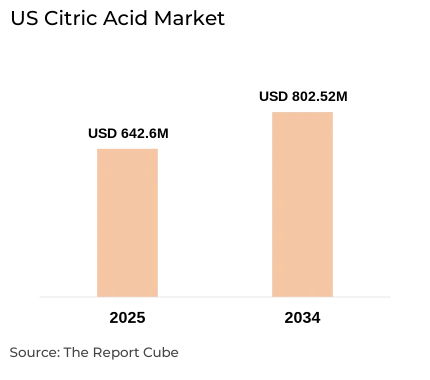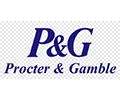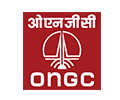
Understand The Key Trends Shaping This Market
Download Free SampleUS Citric Acid Market Overview: Market Size & Forecast (2026–2034)
The US Citric Acid Market is anticipated to register a CAGR of around 2.5% during the forecast period, 2026-34. Additionally, the market size was valued at nearly USD 642.6 million in 2025 and is projected to reach nearly USD 802.52 million by 2034.
Market Analysis & Insights
The US Citric Acid Market growth is instigated by the increasing food & beverage processing industry, strong demand for natural preservatives, and growing usage in pharmaceuticals & detergents. As per the World Integrated Trade Solution (WITS), the United States imported nearly 203,942 tons of citric acid in 2023, valued at about USD 431.74 million, demonstrating substantial reliance on global market suppliers.
Furthermore, domestically, over 90% of US citric acid is produced by the process of fermentation utilizing corn-derived substrates (Aspergillus niger), as stated by the USDA. Thus, this highlights the significance of sustainable feedstock management & fermentation efficiency in maintaining production competitiveness. Also, globally, the US Citric Acid Market is positioned as one of the leading consumers within the international supply network, thus creating a positive market outlook.
Additionally, the US Citric Acid Market is destined to flourish in the coming years, owing to the surging clean-label acidulant demand, sustainable citric acid production techniques, and advanced AI integration. Further, growth in the anhydrous citric acid market, monohydrate citric acid demand, and increasing food preservative & pharmaceutical excipient applications would sustain long-term opportunities in the future years.
What is the Impact of AI in the US Citric Acid Market?
AI advances process control & yields in fermentation (predictive control), optimizes supply-chain procurement, enables predictive maintenance at production sites, and supports R&D for formulation & clean label, speeding product development & lowering operating costs for the Citric Acid Market in the US.
US Citric Acid Market Dynamics
What driving factor acts as a positive influencer for the US Citric Acid Market?
- The food & beverages industries remain the biggest end-user (beverage-heavy usage), supporting sustained demand for food preservatives & acidulant applications.
- Regional bans/limitations on phosphates in detergents & an emphasis on biodegradable ingredients increase citric acid acceptance in cleaning products.
What are the challenges that affect the US Citric Acid Market?
- Citric acid is produced by fermentation (corn/glucose feedstocks). Thus, variations in corn/glucose prices, logistics costs, and heavy dependence on imports to create margin pressure.
- Dependency on a few large manufacturers worldwide could cause short-term tightness & price upsurge, affecting US formulators.

How are the future opportunities transforming the market during 2026-34?
- Progression in pharmaceuticals, nutraceuticals, and high-purity applications supports premium pricing for specialty citric acid.
- On-shoring production or regional footprint expansions (e.g., Jungbunzlauer activity in North America) could minimize import dependency & shorten lead times, opening B2B service models & technical support market revenue.
What market trends are affecting the US Citric Acid Market Outlook?
- Food producers across the US are progressively preferring clean-label, bio-based acidulants, driving a trend toward sustainable, low-waste fermentation procedures.
- Process modernization (AI-enabled bioprocess control, energy optimization) & product variation (effervescent tablet grades, cosmetic-grade citrates) to enhance innovation.
How is the US Citric Acid Market Defined as per Segments?
The US Citric Acid Market Research Reports provide detailed market data & insights in accordance with market segmentation. Some of the segments are:
- Form: Anhydrous & Liquid
- Application: Food & Beverages, Household Detergents & Cleaners, Pharmaceuticals, and Others
By Form:
The Anhydrous form upholds a significant share of the US Citric Acid Market. As this form of citric acid suits powdered beverage mixes, dry food blends, and pharmaceutical tablets where low moisture is fundamental, it further instigates the market demand. Anhydrous citric acid provides storage & formulation advantages (longer shelf life & easier dosing) versus liquid grades, making it the favored option for leading food processors & supplement producers across the US Citric Acid Market.
By Application:
Food & Beverages sector dominates the US Citric Acid Market demand graph by seizing the potential market share. As the food & beverages industry is a potential customer of citric acid as it is broadly used as a food preservative, acidulant, flavor enhancer, and pH regulator in soft drinks, confectionery, dairy and prepared foods. Also, the beverage sector alone accounts for the biggest application portion, instigated by large-scale beverage production & flavor innovation, making F&B the prime demand engine for the US Citric Acid Market in the projected years as well.
US Citric Acid Market: What Recent Innovations Are Affecting the Industry?
- September 2025: Jungbunzlauer acquired a multipurpose site in Thomson, Illinois, marking its growth into US manufacturing & improving regional production abilities.
- July 2025: Tate & Lyle launched its new Mouthfeel Innovation Lab & clean-label ingredient range at IFT FIRST 2025, focused on enhancing texture & natural acidulant performance across beverage & food applications.
What are the Key Highlights of the US Citric Acid Market (2026–34)?
- The US Citric Acid Market is anticipated to reach about 2.5% CAGR during 2026-2034, and is estimated to have a market size of nearly USD 802.52 million in 2034.
- Food & beverage sector accounts for more than 60% of the market value, with pharmaceuticals & personal care products coming in second & third place in terms of share.
- Anhydrous citric acid is still extensively utilized due to its stability & adaptability. However, liquid form is becoming more prevalent across detergents & beverages.
- Producers are responding to the market trend toward clean-label, bio-based acidulants, and sustainable fermentation enhancements.
- By refining supply-chain optimization, fermentation yield, and predictive quality control, artificial intelligence (AI) upturns production efficiency & decreases waste.
How does the Future Outlook of the US Citric Acid Market (2034) Appear?
With the developments in bio-based fermentation, rising clean-label customers' preferences, and augmented domestic production, the US Citric Acid Industry is anticipated to experience steady expansion through 2034. Artificial intelligence (AI)-powered process automation & monitoring is anticipated to increase fermentation efficiency, maximize energy usage, and minimize waste, all of which would raise competitiveness. Also, local manufacturing projects, such as Jungbunzlauer's development in Illinois, might also decrease reliance on imports & stabilize prices, guaranteeing a robust & sustainable supply chain throughout the US Citric Acid Market from 2026 to 2034.
What Does Our US Citric Acid Market Research Study Entail?
- The US Citric Acid Market Research Report highlights the forecast growth rate (CAGR) by anticipating the market size and share.
- The market analysis & market scope sheds light upon the primary industry trends, driving aspects, potential opportunities, growth challenges, and other major factors.
- The US Citric Acid Market Research Report entails details about the most critical shifts in market share in the prominent regions.
- Considering the statistics & the developments by the primary market competitors, our report also strives to demonstrate the most sought-after strategies of the key players.
Table of Contents
- Introduction
- Objective of the study
- Product Definition
- Market Segmentation
- Study Variables
- Research Methodology
- Secondary Data Points
- Companies Interviewed
- Primary Data Points
- Break Down of Primary Interviews
- Secondary Data Points
- Executive Summary
- Market Dynamics
- Drivers
- Challenges
- Opportunity Assessment
- Recent Trends and Developments
- Policy and Regulatory Landscape
- US Citric Acid Market Overview
- Market Size, By Value (USD Million)
- Market Share, By Form
- Anhydrous
- Liquid
- Market Share, By Application
- Food & Beverages
- Household Detergents & Cleaners
- Pharmaceuticals
- Others
- Market Share, By Product Type
- Lye
- Flake
- Others
- Market Share, By Manufacturing
- Membrane Cell
- Diaphragm Cell
- Others
- Market Share, By Company
- Revenue Shares
- Competition Characteristics
- US Citric Acid Market Overview, 2026–2034
- By Value (USD Million)
- By Form
- By Application
- By Product Type
- By Manufacturing
- Forecast 2026–2034 Tables
- Competitive Outlook (Company Profiles)
- Cargill Incorporated
- Company Overview
- Business Segments
- Strategic Alliances/Partnerships
- Recent Developments
- Archer Daniels Midland Company
- Company Overview
- Business Segments
- Strategic Alliances/Partnerships
- Recent Developments
- Tate & Lyle PLC
- Company Overview
- Business Segments
- Strategic Alliances/Partnerships
- Recent Developments
- Jungbunzlauer Suisse AG
- Company Overview
- Business Segments
- Strategic Alliances/Partnerships
- Recent Developments
- MP Biomedicals, LLC
- Company Overview
- Business Segments
- Strategic Alliances/Partnerships
- Recent Developments
- Hawkins Inc.
- Company Overview
- Business Segments
- Strategic Alliances/Partnerships
- Recent Developments
- Others
- Company Overview
- Business Segments
- Strategic Alliances/Partnerships
- Recent Developments
- Cargill Incorporated
- Contact Us & Disclaimer
List of Figure
Figure 1.1: Objective of the Study Flowchart
Figure 1.2: Product Definition and Classification
Figure 1.3: Market Segmentation Overview
Figure 1.4: Study Variables Framework
Figure 2.1: Research Methodology Flow
Figure 2.2: Secondary Data Points Structure
Figure 2.3: Companies Interviewed (List/Map)
Figure 2.4: Primary Data Points Structure
Figure 2.5: Break Down of Primary Interviews
Figure 3.1: Executive Summary Snapshot
Figure 4.1: Market Drivers Illustration
Figure 4.2: Market Challenges Illustration
Figure 4.3: Opportunity Assessment Matrix
Figure 5.1: Recent Trends and Developments Timeline
Figure 6.1: Policy and Regulatory Landscape Overview
Figure 7.1: US Citric Acid Market Size, By Value (USD Million)
Figure 7.2: Market Share by Form (Pie Chart)
Figure 7.2.1: Anhydrous vs. Liquid Distribution
Figure 7.3: Market Share by Application (Pie/Bar Chart)
Figure 7.3.1: Food & Beverages Segment
Figure 7.3.2: Household Detergents & Cleaners Segment
Figure 7.3.3: Pharmaceuticals Segment
Figure 7.3.4: Others Segment
Figure 7.4: Market Share by Product Type
Figure 7.4.1: Lye
Figure 7.4.2: Flake
Figure 7.4.3: Others
Figure 7.5: Market Share by Manufacturing Type
Figure 7.5.1: Membrane Cell
Figure 7.5.2: Diaphragm Cell
Figure 7.5.3: Others
Figure 7.6: Market Share by Company
Figure 7.6.1: Revenue Shares of Top Companies
Figure 7.6.2: Competitive Characteristics Overview
Figure 8.1: US Citric Acid Market Forecast (2026–2034), By Value
Figure 8.2: Forecast by Form
Figure 8.3: Forecast by Application
Figure 8.4: Forecast by Product Type
Figure 8.5: Forecast by Manufacturing Type
Figure 8.6: Forecast Tables Overview
Figure 9.1: Competitive Outlook: Cargill Incorporated Overview
Figure 9.2: Competitive Outlook: Archer Daniels Midland Company Overview
Figure 9.3: Competitive Outlook: Tate & Lyle PLC Overview
Figure 9.4: Competitive Outlook: Jungbunzlauer Suisse AG Overview
Figure 9.5: Competitive Outlook: MP Biomedicals, LLC Overview
Figure 9.6: Competitive Outlook: Hawkins Inc. Overview
Figure 9.7: Competitive Outlook: Other Companies Overview
List of Table
Table 1.1: Objective of the Study Details
Table 1.2: Product Definition and Specifications
Table 1.3: Market Segmentation Table
Table 1.4: Study Variables Overview
Table 2.1: Secondary Data Points Details
Table 2.2: List of Companies Interviewed
Table 2.3: Primary Data Points Details
Table 2.4: Breakdown of Primary Interviews
Table 4.1: Market Drivers Analysis
Table 4.2: Market Challenges Analysis
Table 4.3: Opportunity Assessment Table
Table 5.1: Recent Trends and Developments Table
Table 6.1: Policy and Regulatory Summary
Table 7.1: US Citric Acid Market Size by Value (USD Million)
Table 7.2: Market Share by Form (%)
Table 7.3: Market Share by Application (%)
Table 7.4: Market Share by Product Type (%)
Table 7.5: Market Share by Manufacturing Type (%)
Table 7.6: Market Share by Company (Revenue %)
Table 8.1: US Citric Acid Market Forecast (2026–2034) by Value
Table 8.2: Forecast by Form
Table 8.3: Forecast by Application
Table 8.4: Forecast by Product Type
Table 8.5: Forecast by Manufacturing Type
Table 8.6: Forecast Tables Overview
Table 9.1: Cargill Incorporated: Company Overview & Key Metrics
Table 9.2: Archer Daniels Midland Company: Key Metrics
Table 9.3: Tate & Lyle PLC: Key Metrics
Table 9.4: Jungbunzlauer Suisse AG: Key Metrics
Table 9.5: MP Biomedicals, LLC: Key Metrics
Table 9.6: Hawkins Inc.: Key Metrics
Table 9.7: Other Companies: Key Metrics
Top Key Players & Market Share Outlook
- Cargill Incorporated
- Archer Daniels Midland Company
- Tate & Lyle PLC
- Jungbunzlauer Suisse AG
- MP Biomedicals, LLC
- Hawkins Inc.
- Others
Frequently Asked Questions








